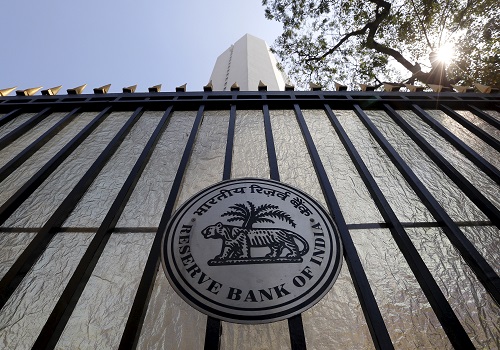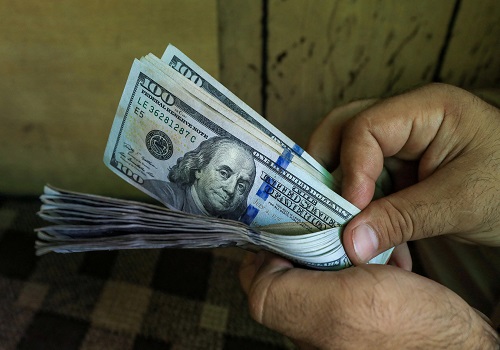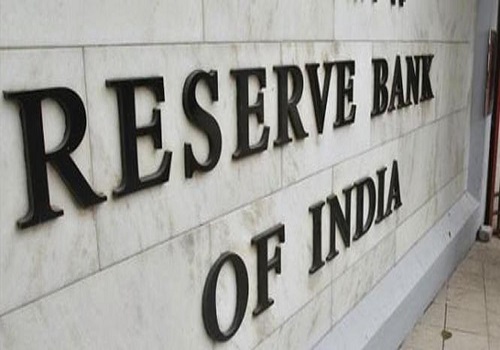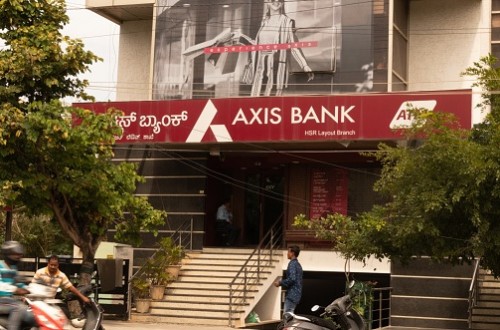Gold trading range for the day is 64970-66300 - Kedia Advisory

Follow us Now on Telegram ! Get daily 10 - 12 important updates on Business, Finance and Investment. Join our Telegram Channel
Gold
Gold faced a decline of -0.84%, closing at 65481, following a robust U.S. inflation report that dampened expectations of an imminent Federal Reserve interest rate cut. The Consumer Price Index (CPI) for February revealed a 0.4% monthly increase and a 3.2% annual rise, surpassing the forecasted 3.1%. The strong inflation data has reduced the likelihood of a U.S. rate cut by June, with the market still pricing in around a 70% chance, according to the CME FedWatch tool. Despite the challenging environment for gold, central banks continued to show a strong appetite for the precious metal. The Central Bank of Turkey emerged as the largest buyer, increasing official gold holdings by 12.2 tons, contributing to a total of 552 tonnes. The People's Bank of China added 10 tons for the 15th consecutive month, reaching a total of 2,245 tonnes, almost 300 tonnes higher than at the end of October 2022. The Reserve Bank of India also bolstered its gold reserves, adding nearly 9 tons in the first monthly increase since October 2023, bringing its total holdings to 812 tonnes. Technically, the gold market is witnessing long liquidation, marked by a -5.55% drop in open interest, settling at 16,548. Despite a price decrease of -554 rupees, gold is finding support at 65225, with potential downside testing towards 64970. Resistance is anticipated around 65890, and a breakout could lead to testing 66300. Investors should stay attuned to global economic indicators and central bank actions, as these factors may influence gold's trajectory in the near term.
Trading Ideas:
* Gold trading range for the day is 64970-66300.
* Gold fell as a US inflation report dimmed Fed’s prospects cutting interest rates.
* U.S. consumer prices increased solidly in February, suggesting some stickiness in inflation.
* Market is still pricing an around 70% chance of a U.S. rate cut by June
Silver
Silver experienced a decline of -0.89%, settling at 73850, following a U.S. inflation report that surpassed market expectations and triggered profit-taking in the precious metal. The consumer price index for February rose 3.2% year-on-year, slightly higher than the anticipated 3.1%, with the core CPI number at 3.8%, exceeding expectations of 3.7%. This prompted a modest boost in the U.S. dollar index, along with a slight uptick in U.S. Treasury yields. In the U.K., a cooling trend in the labor market led traders to reconsider expectations for rate cuts. Despite the U.S. economy adding 275,000 jobs in February, beating forecasts of 200,000, Federal Reserve Chair Jerome Powell indicated a willingness to cut interest rates in 2024, contingent on evidence of inflation aligning with the 2% target. Minneapolis Fed President Neel Kashkari, who initially projected two interest-rate cuts in 2024, mentioned the possibility of revising that stance due to stronger incoming macro data. Technically, the market witnessed long liquidation, with a -2.74% drop in open interest, settling at 22,080. Silver found support at 73,320, and a breach below this level could lead to a test of 72,795. On the upside, resistance was identified at 74,635, with a move above potentially testing 75,425. The market's reaction reflects the delicate balance between economic indicators, central bank signals, and technical factors, influencing traders in navigating the dynamics of the precious metals market.
Trading Ideas:
* Silver trading range for the day is 72795-75425.
* Silver dropped following a key U.S. inflation report
* The CPI for February come in just a bit warmer than expected, at up 3.2%.
* A cooling trend in U.K. labor market, prompting traders to reassess their expectations for rate cuts.
Crude Oil
Crude oil saw a modest increase of 0.06%, settling at 6447, as OPEC maintained its demand growth forecast for 2024 and 2025 amid persistent tensions in the Middle East. The ongoing conflicts, particularly Israeli attacks in the Gaza Strip during the holy month of Ramadan, added geopolitical uncertainties, supporting oil prices. The Energy Information Administration (EIA) reported that U.S. crude oil production remained a global leader for the sixth consecutive year, reaching a record-breaking average of 12.9 million barrels per day (bpd). December saw a new monthly record high, surpassing 13.3 million bpd. Despite the dominance of U.S. production, OPEC stuck to its forecast for robust global oil demand growth, expecting an increase of 2.25 million bpd in 2024 and 1.85 million bpd in 2025. While tensions and OPEC's optimistic outlook supported crude oil prices, technical indicators revealed short covering in the market. Open interest dropped by -20.08%, settling at 2874, alongside a price increase of 4 rupees. Crude oil is currently finding support at 6403, with potential downside testing towards 6359. On the upside, resistance is expected around 6502, and a breakthrough could lead to testing 6557. Investors are navigating a complex landscape marked by geopolitical tensions, production dynamics, and differing outlooks on future oil demand. Monitoring these factors will be crucial for anticipating potential shifts in crude oil prices in the coming sessions.
Trading Ideas:
* Crudeoil trading range for the day is 6359-6557.
* Crude oil gains as OPEC stuck by its forecast for demand growth this year and next
* OPEC said world oil demand will rise by 2.25 mbpd in 2024 and by 1.85 mbpd in 2025.
* Tensions in the Middle East persist as Israeli forces continued their deadly attacks in the Gaza Strip
Natural Gas
Natural gas faced a significant decline of -3.67%, settling at 141.7, driven by forecasts indicating milder weather and lower heating demand over the next two weeks. The market response to the drop in U.S. output over the past month, approximately 6%, indicated that major energy companies such as EQT and Chesapeake Energy were implementing production cuts in response to the prevailing low gas prices. EQT, currently the largest U.S. gas producer, is set to become the country's largest following its merger with Southwestern Energy. Gas output in the Lower 48 U.S. states fell to an average of 100.4 billion cubic feet per day (bcfd) in March, down from 104.1 bcfd in February, reflecting a commitment to production reduction plans. On a daily basis, the output was on track to drop by approximately 6.1 bcfd over the last month, reaching a preliminary seven-week low of 99.3 bcfd. This would mark the lowest daily production since early February 2023, excluding the significant 17.3-bcfd drop in mid-January due to freezing wells. Meteorologists projected warmer-than-normal weather across the Lower 48 states through March 18, with a subsequent shift to near- to colder-than-normal levels from March 19-27. Technically, the market witnessed fresh selling, with a 4.94% gain in open interest, settling at 67,896. Natural gas found support at 138.1, and a breach below this level could lead to a test of 134.4. On the upside, resistance was identified at 148.5, and a move above could see prices testing 155.2.
Trading Ideas:
* Naturalgas trading range for the day is 134.4-155.2.
* Natural gas dropped amid forecasts for milder weather and lower heating demand.
* U.S. energy company CNX Resources said it will delay well completions activities and produce less of the fuel this year.
* Several energy firms, including EQT and Chesapeake Energy, were following through on plans to cut production this year.
Copper
Copper closed down by -0.1% at 736, influenced by a subdued economic growth outlook, poor manufacturing data, and the absence of substantial stimulus support from China, the top metals consumer. The challenging economic conditions were evident in Chile, where copper giant Codelco reported a near 16% year-on-year decline in production in January. However, other producers in the nation contributed to a 0.51% increase in total copper production, reaching 433,800 metric tons, according to the Chilean Copper Commission (Cochilco). Codelco's production was notably down by 15.6% to 107,000 tons, contrasting with increases in output from BHP-controlled mine Escondida (up 4.5% to 97,500 tons) and Collahuasi (up 21.6% to 52,200 tons), a joint venture of Anglo American and Glencore. China's unwrought copper imports for the first two months of 2024, however, rose by 2.6% year-on-year, indicating improving demand in the world's largest consumer of the metal. Technically, the copper market experienced long liquidation, with a -2.8% drop in open interest, settling at 4022, alongside a price decrease of -0.7 rupees. Copper is currently finding support at 733, with potential downside testing towards 730. On the upside, resistance is expected around 739.1, and a breakthrough could lead to testing 742.2. Investors should closely monitor economic indicators, especially from China, as well as production dynamics in key copper-producing regions for insights into potential future price movements.
Trading Ideas:
* Copper trading range for the day is 730-742.2.
* Copper prices dropped pressured by subdued economic growth outlook
* Pressure also seen amid poor manufacturing data and the lack of a big stimulus support from China.
* Production by copper giant Codelco in Chile, in January sank near 16% year-on-year
Zinc
Zinc settled down by -0.16% at 223.05, influenced by the continuous inflow of imported zinc ingots, potentially replenishing part of the supply and reflecting the slow recovery of consumption. Despite this, downside movement remained limited due to ongoing supply concerns, particularly with the Seokpo smelter in South Korea cutting its output by a fifth. The substantial reduction from the world's sixth-largest smelter raises the possibility of narrowing the expected market surplus of 300,000 tons or even pushing it into a deficit. Zinc inventories in Shanghai Futures Exchange-monitored warehouses recorded an 11.3% increase from the previous Friday. The metal found support from hopes of higher demand following remarks from Fed policymakers and softer-than-anticipated labor market data from the U.S., reinforcing expectations of interest rate reductions this year. However, downward pressure on zinc persisted due to uncertainties surrounding the economic recovery of China, the leading consumer of the metal. China's government did not introduce additional stimulus measures during its recent parliament meeting, despite the country's manufacturing activity contracting for the fifth consecutive month in February. Elevated inventories at LME warehouses, exceeding 275,000 tons, also contributed to the negative sentiment surrounding zinc. The International Lead and Zinc Study Group (ILZSG) data showed that the global zinc market deficit increased to 62,600 metric tons in December 2023 from a deficit of 53,500 tons in November. However, the full-year 2023 data indicated a surplus of 204,000 tons, compared to a deficit of 73,000 tons in 2022. Technically, the market observed long liquidation, with a -6.04% drop in open interest, settling at 3,764. Zinc found support at 221.1, and a breach below this level could lead to a test of 219.1. On the upside, resistance was identified at 225.2, with a move above potentially testing 227.3.
Trading Ideas:
* Zinc trading range for the day is 219.1-227.3.
* Zinc dropped amid continuous inflow of imported zinc ingots
* Seokpo smelter in South Korea has cut its output by a fifth.
* The downward pressure was exerted by uncertain economic recovery of leading consumer China.
Aluminium
Aluminium prices saw a modest uptick of 0.37% yesterday, settling at 203.95, as the market anticipated seasonally stronger demand. However, gains were tempered by robust supplies from China, the world's top producer of aluminium. Despite concerns over growing inventory levels in China, analysts suggest that it may be part of a seasonal pattern to prepare for consumption in the second quarter of the year. The surge in aluminium inventory by 85% so far this year in warehouses monitored by the Shanghai Futures Exchange, along with a 2% increase in stocks in LME's registered warehouses, reflects the ample supply situation. China's record aluminium production in 2023 has also contributed to limiting the upside for aluminium prices, particularly given its widespread use in auto parts and power cables. Investors are closely monitoring China's bank lending data, expected to show a sharp pullback in February from a record high in January due to seasonal factors. This data includes total social financing numbers, which serve as a key gauge of future metals consumption, providing insights into potential demand trends. According to reports from the World Bureau of Metal Statistics (WBMS), global primary aluminium production exceeded consumption in December last year, resulting in a supply surplus of 135,500 tons. However, statistics from the International Aluminium Institute (IAI) indicate a slight decrease in global primary aluminium production in January, albeit with a 2.4% increase compared to the same month last year. Technically, the aluminium market witnessed short covering, with a drop in open interest by -6.74% alongside a marginal price increase of 0.75 rupees. Currently, Aluminium finds support at 203, with a potential downside test at 202, while resistance levels are likely to be encountered at 204.8, with a breakthrough potentially leading to prices testing 205.6.
Trading Ideas:
* Aluminium trading range for the day is 202-205.6.
* Aluminium gains as the market factored in seasonally stronger demand
* But gains seen capped by robust supplies from top producer China.
* Aluminium inventory has grown 85% so far this year to 184,358 metric tons in ShFe warehouses.
Cottoncandy
Cotton prices experienced a slight decline yesterday, settling down by -0.96% at 62040, driven by profit booking activities following earlier gains. This came in the wake of the latest U.S. cotton forecasts for the 2023/24 season, which showed lower production and ending stocks compared to the previous month's estimates. Reduced production in the U.S., reflected in the March 8 Cotton Ginnings report, led to a decrease of 334,000 bales to 12.1 million, while ending stocks were lowered by 300,000 bales to 2.5 million. Despite this, the projected marketing year average price received by upland producers remained unchanged at 77.0 cents per pound. On the global front, cotton supply and demand estimates for 2023/24 indicated higher production, consumption, and trade, albeit with lower ending stocks. While production was slightly higher due to increased output in India, consumption saw a significant rise driven by China and India. World trade also saw an uptick, with higher imports projected for China, India, Australia, and Turkey. However, ending stocks witnessed a marginal decline, indicating a tighter market scenario. Meanwhile, the Southern India Mills’ Association (SIMA) advised textile mills in southern States to avoid panic buying of cotton. The recent surge in domestic cotton prices prompted caution, with prices of the widely-used Shankar-6 variety reaching almost ?62,000 a candy from ?55,300 two weeks prior. The Committee on Cotton Production and Consumption estimated production for the current season at 316.57 lakh bales, with imports at 12 lakh bales and domestic consumption at 310 lakh bales. Despite increased capacity utilization at mills and significant contracts for exports, concerns lingered regarding the sustainability of export demand as domestic prices approach international levels. In Rajkot, a major spot market, cotton prices ended slightly lower at 29482.05 Rupees, dropping by -0.05 percent. From a technical perspective, the market observed fresh selling, with a gain in open interest by 0.84%. Currently, Cottoncandy finds support at 61740, with a potential downside to 61450, while resistance is likely to be encountered at 62500, with a breakthrough potentially leading to prices testing 62970 levels.
Trading Ideas:
* Cottoncandy trading range for the day is 61450-62970.
* Cotton dropped on profit booking after prices gained as US has lower ending stocks
* Support also seen as severe cold in China has affected the crop
* SIMA urges textile mills to avoid panic buying as cotton prices rise, global supply expected to increase post July.
* In Rajkot, a major spot market, the price ended at 29482.05 Rupees dropped by -0.05 percent.
Turmeric
Turmeric prices experienced a notable decline yesterday, settling down by -2.6% at 18672, as profit booking ensued following a period of upward momentum. The surge in prices was initially fueled by below-normal supplies and robust festive demand, which maintained a positive bias in the market. However, the impact of lower production became evident as arrivals in major APMC markets during March 2024 were significantly lower compared to the previous year. This prevailing supply tightness is expected to entice stockists to capitalize on any price dips, indicating a potential for price support in the near term. The seasonality of turmeric prices suggests a historical trend of higher prices during March, primarily driven by festive buying. With a series of festivals lined up in the coming months and the onset of the wedding season, demand is anticipated to remain active, further supporting prices. However, production is forecasted to decline by approximately 14% year-on-year due to reduced cultivation area and tumbling yields, with estimates ranging between 9.2-9.5 lakh tonnes. On the export front, turmeric exports during April-December 2023 experienced a marginal decline of 2.27% compared to the same period in 2022. December 2023 witnessed a rise in exports compared to November 2023, but a decline compared to December 2022. Similarly, turmeric imports during April-December 2023 decreased by 25.43% compared to the previous year. However, December 2023 saw a slight drop compared to November 2023 but a significant increase compared to December 2022. In Nizamabad, a major spot market, turmeric prices ended higher at 16493.5 Rupees, gaining 7%. From a technical standpoint, the market observed long liquidation, with a drop in open interest by -0.19% to settle at 15900. Currently, Turmeric finds support at 18216, with a potential downside to 17762. Resistance is likely to be encountered at 19412, with a breakthrough potentially leading to prices testing 20154 levels.
Trading Ideas:
* Turmeric trading range for the day is 17762-20154.
* Turmeric dropped on profit booking after prices rose amid below normal supplies
* Festivals ahead in coming months and commencement of wedding season demand is likely to keep buyers engage.
* Production is likely to be dropped by about 14% Y-o-Y due to lower area under turmeric.
* In Nizamabad, a major spot market, the price ended at 16493.5 Rupees gained by 7 percent.
Jeera
Jeera faced a downward trend in prices yesterday, settling down by -0.97% at 25480, largely influenced by a significant surge in acreage during the current rabi season. Farmers in key producing states of Gujarat and Rajasthan expanded cultivation, driven by the record prices observed in the previous marketing season. This expansion in acreage reflects the strong correlation between market prices and cultivation decisions. Despite the increased acreage, the downside in prices remained limited due to emerging weather risks in Rajasthan and Gujarat, which could potentially adversely affect yields. In Gujarat, jeera cultivation witnessed a substantial increase, covering 5.60 lakh hectares, marking a remarkable 160% rise from the previous year. This surpasses the normal acreage of 3.5 lakh hectares in the state. Similarly, Rajasthan experienced a 25% increase in cultivation, reaching 6.90 lakh hectares compared to the previous year. However, global demand for Indian jeera declined as buyers preferred alternative sources like Syria and Turkey due to comparatively higher prices in India. Export volumes during April-December 2023 dropped by 29.95% compared to the same period in 2022. December 2023 showed a significant rise in exports compared to November 2023, but a slight decline compared to December 2022. In Unjha, a major spot market, jeera prices ended slightly higher at 28335.2 Rupees, gaining 0.01%. From a technical perspective, the market witnessed fresh selling, with open interest increasing by 3.31% to settle at 2718. Currently, Jeera finds support at 25130, with a potential downside to 24780. Resistance is likely to be encountered at 25760, with a breakthrough potentially leading to prices testing 26040 levels.
Trading Ideas:
* Jeera trading range for the day is 24780-26040.
* Jeera dropped as jeera acreage hits a four-year high in current season.
* However downside seen limited in wake of emerging weather risk in Rajasthan and Gujarat that may affect the yield.
* Stockists are showing interest in buying on recent downfall in prices triggering short covering.
* In Unjha, a major spot market, the price ended at 28335.2 Rupees gained by 0.01 percent.
Views express by all participants are for information & academic purpose only. Kindly read disclaimer before referring below views. Click Here For Disclaimer










Tag News

Evening Track : Gold prices steady amid softer U.S. Inflation reignite hopes that the Fed mi...
More News

Sell Jeera Apr @ 25800 SL 26300 TGT 25200-24800. NCDEX - Kedia Advisory





 320-x-100_uti_gold.jpg" alt="Advertisement">
320-x-100_uti_gold.jpg" alt="Advertisement">






